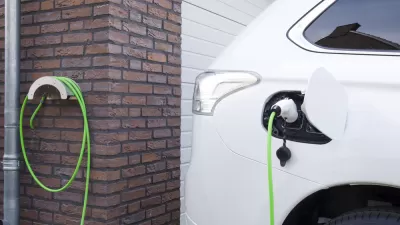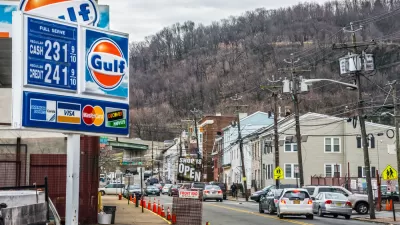When the N.J. Department of Environmental Protection adopted new rules for power plants on June 17, the Garden State becomes the tenth to participate in a cap-and-trade program known as the Regional Greenhouse Gas Initiative.

First-term Gov. Phil Murphy (D) "announced Monday that the New Jersey Department of Environmental Protection (DEP) has formally adopted two rules that will allow the state to rejoin the Regional Greenhouse Gas Initiative (RGGI)", reports HJ Mai for Utility Dive on June 18. The membership takes effect Jan. 1, 2020, when New Jersey will join the nine Mid-Atlantic and New England states in the program: Connecticut, Delaware, Maine, Maryland, Massachusetts, New Hampshire, New York, Rhode Island, and Vermont.
"We congratulate and salute New Jersey on this historic step," said Ben Grumbles, Secretary of the Maryland Department of the Environment and Chair of the RGGI, Inc. Board of Directors, in a June 17 statement [pdf]:
"The effects of climate change and pollution operate across state lines, so it is important for states to work together as a region to take on these issues and move towards a cleaner power sector.”
The RGGI states look forward to welcoming Commissioner Catherine R. McCabe of the New Jersey Department of Environmental Protection and President Joseph L. Fiordaliso of the New Jersey Board of Public Utilities to the RGGI, Inc. Board of Directors on behalf of New Jersey.
The rules adoption by DEP marks the completion of an executive order that Murphy signed on Jan. 29, 2018, just two weeks after being sworn into office.
"While RGGI is not a silver bullet to reduce all our carbon emissions, it's an incredible first step to reduce pollution from our fossil fuel plants and move us to a clean, renewable energy economy," said Doug O'Malley, director of Environment New Jersey (an affiliate on Environment America), as reported by NJ Advance Media for NJ.com on Jan. 29.
The rules adoption also marks the completion of one of the five parts of a comprehensive energy plan that then-candidate Murphy outlined in April 2017. He went on to beat his Republican opponent by 14 points, winning with 56 percent of the vote, on Nov. 7, 2017.
Reversing former Gov. Chris Christie's action
initiated discussions in 2003 to develop the nation's oldest cap-and-trade program to reduce carbon emissions, though it's restricted to electricity generation. RGGI became operational on January 1, 2009, with the same ten states participating then as there will be on January 1 next year.
On May 26, 2011, Murphy's predecessor, Republican Gov. Chris Christie, announced "that the state will pull out of the region’s 'gimmicky' cap-and-trade program by the end of the year," reported Christopher Baxter of NJ Advance Media for NJ.
“Climate change and sea-level rise affect us all, and as a coastal state, New Jersey is especially vulnerable to the impacts of global warming,” said Governor Murphy in a statement on June 17.
“The reckless decision to pull out of the Regional Greenhouse Gas Initiative in 2012 cost the state [$279 million] in revenue that could have been used to put toward initiatives to reduce greenhouse gas emissions and improve the health of our residents.
Murphy added that the membership in the cap-and-trade program "will propel us on a path to 100 percent clean energy by 2050," the third goal in his aforementioned five-part energy plan he unveiled as a candidate.
What DEP did
- The first rule the department adopted set the initial carbon-dioxide cap for the state’s electricity generation sector which will decline by 30 percent through 2030.
The cap was set at 18 million tons, which O'Malley of Environment New Jersey criticized as too high, reported Dana Bate of WHYY (Philadelphia NPR affiliate) on January 25, 2019. [Audio available]. He would prefer to set a 12 million ton-per-year cap.
- The second rule "establishes the framework for how the DEP, the New Jersey Economic Development Authority, and the New Jersey Board of Public Utilities will implement a system to spend proceeds from RGGI carbon-dioxide allowance [or "permit"] auctions, with an emphasis on projects that will benefit environmental justice in certain communities," according to the governor's office.
RGGI critique
"A 2017 report [pdf] by the Congressional Research Service found that “from a practical standpoint, the RGGI program’s contribution to directly reducing the global accumulation of [greenhouse gas] emissions in the atmosphere is arguably negligible," noted WHYY's Bate.
While "the 'cap' didn’t necessarily drive down emissions, the price signal it created and the subsequent 'trade' allowed for investments in technologies that did contribute somewhat to the decline.
On the flip side, a 2015 report from Duke University’s Nicholas Institute for Environmental Policy Solutions found that the region’s emissions would have been 24 percent higher without RGGI, and that RGGI accounted for about half the region’s emissions reductions from 2009 to 2015.
According to Jordan Stutt, carbon programs director at Acadia Center, a clean-energy research and advocacy organization with offices throughout the northeastern United States, "[e]missions from power plants have dropped 51 percent from 2008, a year before the program started, to 2017," noted Bate.
Transportation emissions
Bate also pointed to an indirect way that RGGI will help tackle the most challenging source of emissions. "In New Jersey, 16 percent of its carbon emissions come from the electricity generating sector, but about 42 percent comes from transportation."
“It’s also been significant in that it’s served as a blueprint for policies beyond this region’s power sector,” said Stutt.
Indeed, all the RGGI states, as well as Pennsylvania, New Jersey, and Virginia have joined in the Transportation and Climate Initiative, which addresses carbon emissions generated by the transportation sector and is based on the RGGI model. Among the participating states, transportation accounts for a quarter to more than half of all carbon emissions. [See related post.]
“We’ve made great strides over the years in the electric generating sector,” said Paul Baldauf, New Jersey’s assistant commissioner for air quality, energy and sustainability, “but transportation, that’s the big piece in the next few years that we have to address.”
Setback in Virginia
"Virginia Gov. Ralph Northam (D) said last month that he won't veto language in the state budget that prevents the Commonwealth from joining RGGI," adds Mai for Utility Dive. Northam, like Murphy, was elected in 2017, and continued the work of his Democratic predecessor, Terry McAuliffe, to join RGGI.
Unlike his N.J. counterpart, Northam had to work with a Republican-controlled House of Delegates and state Senate, aka General Assembly, who are not keen on fighting climate change with market-based measures.
As posted in April, the State Air Pollution Control Board voted 5-2 to adopt a regulation that ensures that Virginia is 'trading-ready' to allow for the use of market-based mechanisms and the exchange of CO2 allowances through a multi-state carbon market. However, Republican lawmakers added language into the state budget that effectively prevented Virginia from participating.
Northam had been urged by environmental groups to line-item veto the language, "[b]ut his advisers apparently believed he lacked the legal authority to veto that language," reported Gregory S. Schneider for The Washington Post.
"However, Northam is directing the state's Department of Environmental Quality to find ways to implement a recently finalized rule to reduce carbon emissions from large fossil fuel-fired power plants 30% by 2030," adds Mai for Utility Dive.
Could Pennsylvania be next?
In a Feb. 5 op-ed in the Pennsylvania Capital-Star, Davitt Woodwell, president of Pittsburgh-based Pennsylvania Environmental Council, and Dan Grossman of Environmental Defense Fund, observe that "Pennsylvania is the only state from Maine to Virginia without a limit on carbon pollution from its power plants – or a concrete plan to put limits in place."
Noting that Gov. Tom Wolf signed an executive order on Jan. 8 establishing the first statewide goal to reduce carbon pollution in Pennsylvania, they argue that "the Commonwealth needs immediately to set a declining limit on carbon pollution from our electric power sector (the source of 37 percent of the state’s energy-related emissions) in order to reach the Governor’s reduction goals."
A flexible, market-based policy can be deployed to achieve that limit, creating a framework that incentivizes the lowest-cost pollution reductions while enhancing the deployment and utilization of zero-emission energy resources. One such approach could be for Pennsylvania to join the Regional Greenhouse Gas Initiative (RGGI)...
Joining RGGI and other climate policy proposals are included in PEC's white paper, "Energy and Climate: A Policy Pathway Forward for Pennsylvania," accessible on its Deep Decarbonization webpage.
Multi-media:
- WHYY (Philadelphia NPR affiliate): New Jersey looks to rejoin RGGI to tackle greenhouse gas emissions, January 25, 2019
- CBS Pittsburgh (via YouTube): Gov. Tom Wolf Issues Executive Order To Reduce Greenhouse Gases, Jan 8, 2019
Related in Planetizen:
-
An East Coast Cap-and-Invest Approach to Reducing Transportation Emissions, December 20, 2018
-
Gubernatorial Elections Have Environmental Consequences, November 13, 2017
Hat tips to Andrew McKeon/RGGI and Kelsey Tamborrino/POLITICO Morning Energy.
FULL STORY: New Jersey adopts rules to rejoin RGGI, heading to 100% clean energy by 2050

Trump Administration Could Effectively End Housing Voucher Program
Federal officials are eyeing major cuts to the Section 8 program that helps millions of low-income households pay rent.

Planetizen Federal Action Tracker
A weekly monitor of how Trump’s orders and actions are impacting planners and planning in America.

Ken Jennings Launches Transit Web Series
The Jeopardy champ wants you to ride public transit.

Opinion: Transit Agencies Must View Service Cuts as Last Resort
Reducing service could cripple transit systems by pushing more riders to consider car ownership, making future recovery even less certain.

‘Smart Surfaces’ Policy Guide Offers Advice for Building and Maintaining Urban Tree Canopies
Healthy, robust tree canopies can reduce the impacts of extreme heat and improve air quality.

New Jersey Lawsuit Targets Rent-Setting Algorithms
The state of New Jersey is taking legal action against landlords and companies that engage in what the state’s Attorney General alleges is illegal rent fixing.
Urban Design for Planners 1: Software Tools
This six-course series explores essential urban design concepts using open source software and equips planners with the tools they need to participate fully in the urban design process.
Planning for Universal Design
Learn the tools for implementing Universal Design in planning regulations.
Heyer Gruel & Associates PA
Ada County Highway District
Institute for Housing and Urban Development Studies (IHS)
City of Grandview
Harvard GSD Executive Education
Toledo-Lucas County Plan Commissions
Salt Lake City
NYU Wagner Graduate School of Public Service





























